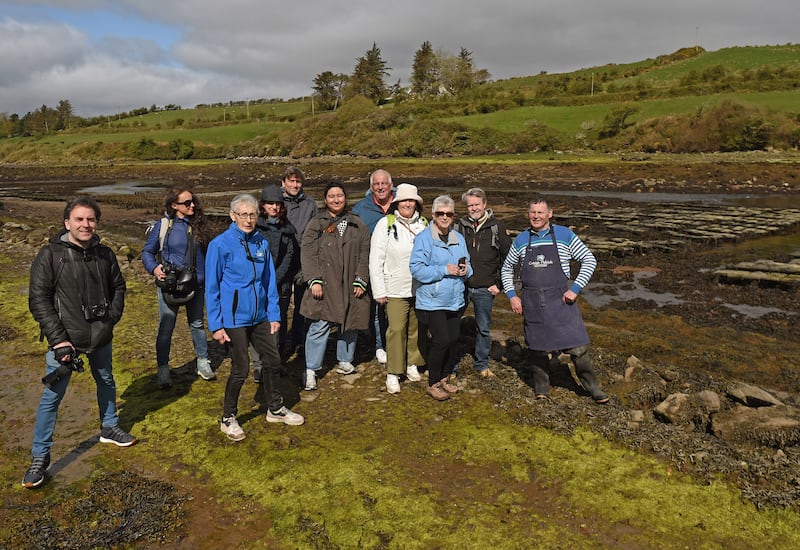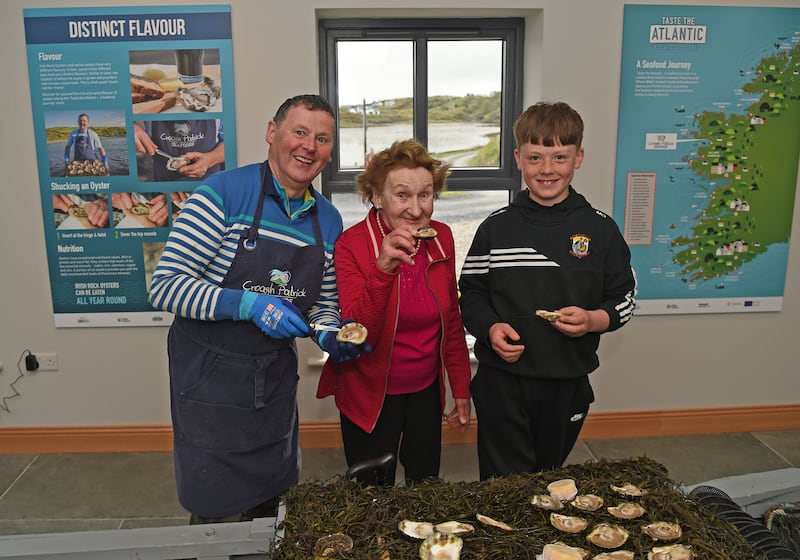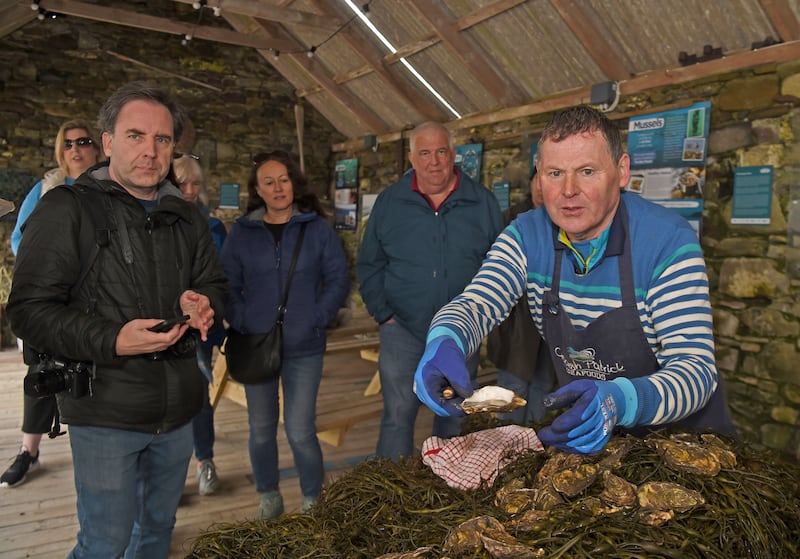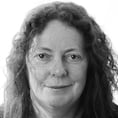Here’s an experiment for those readers who grew up in Ireland, or have since moved to Ireland. People who live here, in other words. If you had to choose three things to describe what you think the allure of Ireland is to the international visitor, what would those three words be?
This is the question I asked various international journalists who were in Ireland recently on a press trip hosted by Fáilte Ireland. As part of its international marketing budget, Fáilte Ireland regularly hosts journalists from around the world to showcase various elements of Ireland. There are food-themed press trips, culture, city breaks, coastal-based trips and many others. Some host only influencers, some host more traditional media from newspapers, magazines, guide books or travel websites.
The five-day trip that I joined for a day and a night was to promote 10 years of the branding of the Wild Atlantic Way, focusing on the northern counties. As we sat around a long table at a restaurant in Westport on the first night of the trip, I asked the visiting journalists three things that both they and their home audiences associated with Ireland as a destination.
“Landscape, music and fairies.”
“Pubs, music and golf.”
“Rural landscapes. Beer. Pubs in scenic places.”
“Green, pubs, music.”
“Friendly people. Amazing landscapes. Pubs.”
“English speaking, but not Britain. No hustle. Safe.”

I ask Ingrid Augustin, the German journalist from Schwabische Zeitung, what she means by “fairies”. I feel I must point out to the listening journalists that fairies do not reside in Ireland, or at least, they have never shown themselves to me. “The romantic feeling people have about Ireland,” Augustin says by way of explanation. “That Celtic thing. A green land. Traditional music. The Banshees of Inisherin. The wild Atlantic coastway that nobody knew existed until 10 years ago.”
We had started the day at Dublin Airport, where I joined up with the group as they arrived on various flights that morning or the evening before. Eight of the party of 10 were there: two were on delayed flights.
Caroline Cole, Fáilte Ireland’s international publicity officer, and long-time guide Conor Ellard are leading the group. A planned schedule waits for nobody, so arrangements were made for a car to meet the two delayed journalists later, and drive them to Westport. Don’t ask me what that taxi ride cost. I’d say it was a fortune.
Our driver is Jonny Bambury, who wears what looks to me like a trilby, as indeed does Ellard. Over the time I am with them, they put their hats on and take them off with fine flourishes.
The eight journalists and photographers on the bus are: Ursula Maxwell, Canadian, of Black Press; Alessia Trivelli, Italy, of Adnkronos; Olivia Le Sidaner, France, of routard.com; Frank van der Vleuten, Netherlands, of De Telegraaf; Thomas Andreasen, Denmark, of Kristeligt Dagblad; Geert D’Hulster of Gazet Van Antwerpen, Belgium, of Het Nieuwsblad; Javier Garcia, Spain, of Destinos; and Ingrid Augustin. The two who will join us later that day are Christine Loomis and Mina Rahim.
Tourism Ireland, which markets the island of Ireland, estimates that overseas tourism was worth €6 billion in 2023.
“Between the 10 journalists on this trip, the potential audience reach will be in the region of 40 million,” Cole says.
Soon after we are settled in the minibus, Ellard takes a mic and starts speaking. The man should be on the radio with his own show, so mellifluous-sounding is his voice. It’s the first sunny day after weeks of rain and showers. Along with the population stats and where the Wild Atlantic Way begins and ends, he tells the visitors: “Irish people are quite obsessed by daylight hours and weather. We’re only over the winter solstice when we’re saying: ‘There’s a grand stretch in the evenings.’”
When the ‘reek’ of Croagh Patrick is pointed out, its tiny church at the top clearly visible on this clear day, Andreasen asks: ‘Is it the main form of tourism here?’ And, ‘Are there hotels up there? Can you stay the night?’
Our first overnight is to be in Westport, at the Clew Bay Hotel. On the bus en route, Ellard announces that the hotel hosts, Darren Madden and Maria Ruddy, have offered everyone an unscheduled Irish coffee-making demonstration in between a short tour of Westport town and dinner.
At Westport, Ellard takes us all on a short walking tour of the town. Along the way, he points out two different churches, and mentions that one is Catholic. Has anyone any questions? They don’t.
When the ‘reek’ of Croagh Patrick is pointed out, its tiny church at the top clearly visible on this clear day, Andreasen asks: “Is it the main form of tourism here?” And, “Are there hotels up there? Can you stay the night?”
As we’re walking back to the hotel, Ellard tells me that he’ll talk about anything to visitors, with the exception of politics, which he always veers away from.
After Darren Madden’s entertaining Irish coffee-making class – during which he tells us that Shannon Airport is in Limerick, much to this Clare woman’s outrage – we head to Covey’s restaurant at the Westport Plaza Hotel for dinner. En route there, I learn something from Ellard I hadn’t known: the restaurant gets its name from the slang for Westport-born people, which is “Covey”.
Over dinner, my fellow journalists discuss what they believe the view of Ireland their compatriots hold. I mention that I am surprised fairies, landscape and music still feature so highly in 2024. What about our modern culture? Is anyone interested in politics?
“I don’t think American people coming to Ireland think much about politics,” Christine Loomis says. “I think if you asked 10 Americans what was going on in Ireland right now, they’d have no idea. Of those 10, probably eight out of 10 wouldn’t know the difference between Northern Ireland and Ireland. If that.”
“Europeans know all about Irish politics, because of Brexit,” Ingrid Augustin says.
Olivia Le Sidaner points out that tourists to Ireland seek different things at different ages. “The young people go to Dublin and Galway to enjoy the pub, and to party. The older ones are dreaming of the scenery. French people love west Cork and Connemara. They want to be inspired by landscape.”
“It’s easier to convince Flemish people to go to Ireland than Albania,” Geert D’Hulster says. “It seems a safer place. And Ireland has kept its identity.”
I ask him to define what he thinks is Ireland’s identity.
“The main thing is, it’s not England, or Britain. It’s a country on its own. And people are easier to interact with here. They are more friendly. But I don’t think Ireland is a working-class holiday destination. It’s not a cheap place to come on holiday, like Spain or Turkey.”

After dinner, there is a rowdy session in Matt Molloy’s bar, where everyone takes out their phones and starts videoing as The Rose of Aranmore is played.
“Why is there nowhere to sit?” I’m asked. It’s a Monday night in mid-April and the bar is full. I can only imagine how full it gets in the summer months.
“There aren’t always seats when there is music playing,” I say.
“Why not?” I’m asked, and I don’t have any answer for that, other that we’re probably a lot more used to spending time standing up in popular bars in Ireland than our visitors. I was personally quite delighted to have scored the feat of a scrap of ledge to put my pint of Guinness on, and had no expectations of a seat, but I realise most tourists with no experience of traditional Irish pubs have a reasonable desire to sit down.
“The bus leaves at 9am,” Ellard reminds people, as he heads back to the hotel, leaving people tapping their feet.
[ Mayo’s Great Western Greenway scoops top European awardOpens in new window ]
[ New life along old lines – Norman Freeman on the greenways of IrelandOpens in new window ]
Everyone is on time the next morning. They need to be, as a very long day lies ahead. Press trips almost always have very full itineraries. The most efficient use of time for the expense of hosting people from overseas, whose flights will also have been covered, is to try to showcase as many of the relevant attractions as possible. For instance, the schedule for this second day of the four-day Wild Atlantic Way-themed trip to Ireland goes like this.
9am: Depart Westport.
9.30am: Croagh Patrick Seafoods, with demonstration by owner Padraic Gannon, and oyster-tasting.
Noon: Lunch of local produce at Nevin’s Newfield Inn
1.30pm: Visit to Old Irish Goat Centre.
2.30pm: Cycle five kilometres of the Great Western Greenway from Achill’s Michael Davitt Bridge to Cashel.
Tour of deserted village, Achill.
Walk on Keem beach. (There had been talk about a swim for those brave enough for Atlantic immersion in April.)
Drive along Achill’s coastal route.
7pm: Dinner at Mulvaney Park Hotel.
9pm: Expedition to Wild Nephin National Park to experience Mayo’s Dark Sky Reserve.
Return to hotel by midnight.
One of the things about a press trip is that things often happen in a different order to the way they would should you actually be on holidays. And so it is that at 9.30am, at Croagh Patrick Seafoods, we are eating oysters; one of my very favourite things to do, but usually when it is at least noon. Not usually shortly after breakfast.

Croagh Patrick Seafoods is located in picturesque Clew Bay, and has been in oyster business since the 1980s, when Padraig Gannon swapped farming dairy cows for farming the waters that surrounded the family farm. Passing members of the public would never have known this, no matter how many bivalves they like to consume, because the place did not have a visible public presence.
“Oyster farm tours” are now offered regularly at noon: €35 for a tour of the farm with Gannon, and half a dozen of the freshest oysters you’ll probably ever have. “We had to do something in lockdown,” Gannon explains. With all the restaurants closed, including those in France they usually exported to, there was nothing to do with the harvest, except put up a sign, cobble together a tour and offer a tasting.
Gannon shows everyone the oyster sacks that have to be physically shaken twice monthly at low tide – a job which he personally still does, with help from others – and explains the husbandry of native oysters and Pacific oysters.
The visiting journalists go wild for his stories, his authenticity, the backdrop of Clew Bay, his skill opening oysters for all to try and the unexpected appearance of his mother, who also lives on the family farm and who shakes hands with everyone and asks their name, charming everyone she meets. A young Gannon child with red hair starts skilfully playing haunting tunes on the accordion in the background. It’s like a John Hinde postcard come alive, in the best possible way.
“Do you ever find pearls in your oysters?” someone asks.
“The people that come to see this place are the pearls,” Gannon answers.
- Sign up for push alerts and have the best news, analysis and comment delivered directly to your phone
- Find The Irish Times on WhatsApp and stay up to date
- Listen to our Inside Politics podcast for the best political chat and analysis











